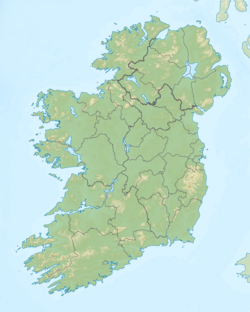Lough Gill
| Lough Gill Loch Gile |
|
|---|---|

Lake and Innisfree
|
|
| Location | County Sligo & County Leitrim, Ireland |
| Coordinates | 54°15′N 08°22′W / 54.250°N 8.367°WCoordinates: 54°15′N 08°22′W / 54.250°N 8.367°W |
| Primary inflows | Bonet River |
| Primary outflows | River Garavogue |
| Basin countries | Ireland |
| Max. length | 8 km (5.0 mi) |
| Max. width | 2 km (1.2 mi) |
| Surface area | 12.8 km2 (4.9 sq mi) |
| Max. depth | 31 m (102 ft) |
| Surface elevation | 7 m (23 ft) |
| Islands | ~20, including Church Island |
| Settlements | Sligo |
Lough Gill Irish: Loch Gile meaning bright or radiant lake is a freshwater lough (lake) mainly situated in County Sligo, but partly in County Leitrim, in Ireland. The lake is mentioned in the poetry of W. B. Yeats.
Lough Gill and the district of Calry adjoining it is famous for its beautiful scenery.
Lough Gill is about 8 km or 5 miles long and 2 km or 1 mile wide. The Lough Gill system consists of the river Bonet that flows into the eastern end of the lake and the River Garavogue which drains the lake to the west near Sligo Town.
The picturesque lake is surrounded by woodlands, such as Slish Wood, Dooney Rock, and Hazelwood all of which contain popular nature trails and viewing points along the lake. The wooded hills of Slieve Killery and Slieve Daean dominate the south shore.
It is a popular location for birdwatchers.
Lough Gill has a unique micro climate and is noted for the high number of rare or scarce animal and plant species. It is a candidate SAC (Area of Special Conservation) for three habitats listed on Annex I of the E.U. Habitats Directive, including one with priority status including, old oak woodlands, alluvial forest, and the naturally eutrophic lake, all habitats listed in the EU Habitats Directive.
The Lough Gill water system gets a very early run of spring salmon.
The vegetation of the area was dominated by mixed woodland from 4,600 BC to at least 1400 AD. Scots pine was dominant until 3,400 BC. In a scientific study, Arbutus unedo pollen was found at Slish Lake dating from as early as 100 AD, and so it is considered native to this area.
The woods surrounding the lake are dominated by oak (Quercus spp.), rowan (Sorbus aucuparia) and willows (Salix spp.).The shores of the lake are home to the northernmost specimens of the rare Mediterranean strawberry tree (Arbutus unedo) in the world. It is a small evergreen tree of the family Ericaceae, which in Ireland can grow to be a forest tree, reaching heights of up to 15 metres. Its Irish name is caithne.
...
Wikipedia

